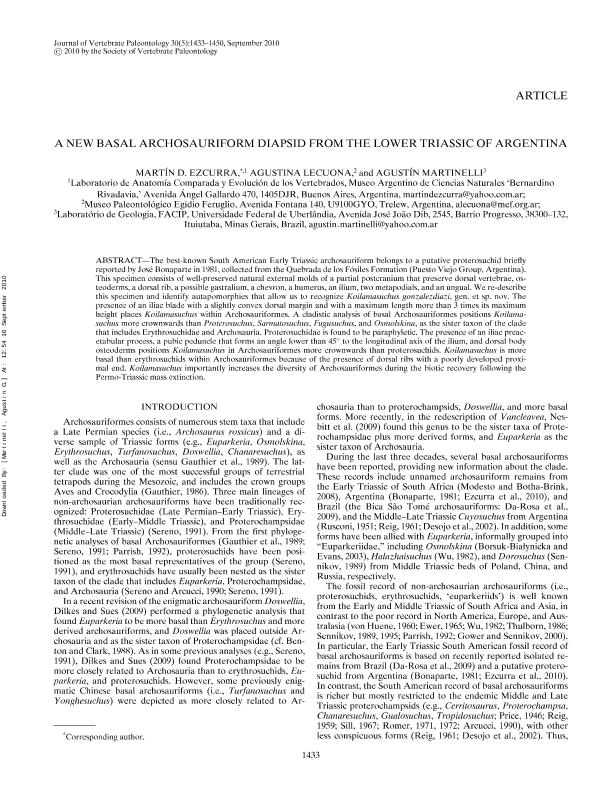Artículo
A new basal archosauriform diapsid from the lower Triassic of Argentina
Fecha de publicación:
15/09/2010
Editorial:
Society of Vertebrate Paleontology
Revista:
Journal of Vertebrate Paleontology
ISSN:
0272-4634
e-ISSN:
1937-2809
Idioma:
Inglés
Tipo de recurso:
Artículo publicado
Clasificación temática:
Resumen
The best-known South American Early Triassic archosauriform belongs to a putative proterosuchid briefly reported by Jose Bonaparte in 1981, collected from the Quebrada de los F ´ osiles Formation (Puesto Viejo Group, Argentina). ´ This specimen consists of well-preserved natural external molds of a partial postcranium that preserve dorsal vertebrae, osteoderms, a dorsal rib, a possible gastralium, a chevron, a humerus, an ilium, two metapodials, and an ungual. We re-describe this specimen and identify autapomorphies that allow us to recognize Koilamasuchus gonzalezdiazi, gen. et sp. nov. The presence of an iliac blade with a slightly convex dorsal margin and with a maximum length more than 3 times its maximum height places Koilamasuchus within Archosauriformes. A cladistic analysis of basal Archosauriformes positions Koilamasuchus more crownwards than Proterosuchus, Sarmatosuchus, Fugusuchus, and Osmolskina, as the sister taxon of the clade that includes Erythrosuchidae and Archosauria. Proterosuchidae is found to be paraphyletic. The presence of an iliac preacetabular process, a pubic peduncle that forms an angle lower than 45◦ to the longitudinal axis of the ilium, and dorsal body osteoderms positions Koilamasuchus in Archosauriformes more crownwards than proterosuchids. Koilamasuchus is more basal than erythrosuchids within Archosauriformes because of the presence of dorsal ribs with a poorly developed proximal end. Koilamasuchus importantly increases the diversity of Archosauriformes during the biotic recovery following the Permo-Triassic mass extinction.
Palabras clave:
Archosauriamorpha
,
Lower Triassic
,
Argentina
Archivos asociados
Licencia
Identificadores
Colecciones
Articulos(SEDE CENTRAL)
Articulos de SEDE CENTRAL
Articulos de SEDE CENTRAL
Citación
Ezcurra, Martin Daniel; Lecuona, Agustina; Martinelli, Agustín Guillermo; A new basal archosauriform diapsid from the lower Triassic of Argentina; Society of Vertebrate Paleontology; Journal of Vertebrate Paleontology; 30; 5; 15-9-2010; 1433-1450
Compartir
Altmétricas




